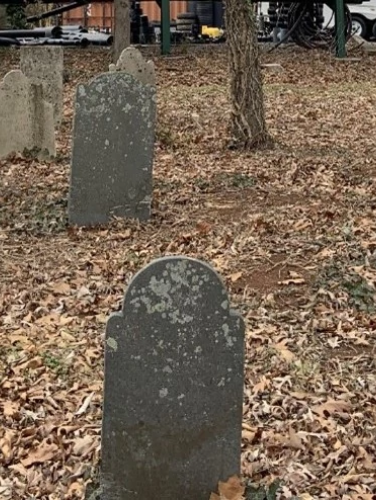
Dinkins Property Cemetery
(ca. 1795)
The Dinkins Property Cemetery is one of Mecklenburg County’s oldest and best preserved family cemeteries.
10600 Nations Ford Rd, Charlotte, NC 28273
Located near the intersection of Nations Ford Road and I-485, the Dinkins Property Cemetery is one of Mecklenburg County’s oldest and best-preserved family cemeteries. It is associated with the Dinkins family who immigrated to the United States in 1717. Originally Welsh, members of the Dinkins family migrated to Scotland in the sixteenth century and later to Londonberry in Northern Ireland before brothers John, James, and Thomas Dinkins set sail for Charleston, South Carolina. By 1723, the three brothers had settled in Mecklenburg County.
Property Quick Links
John Rufus Dinkins Sr. (c. 1731-1811), a descendant of original settler James Dinkins, purchased a 241-acre tract from Francis Smart in 1795, but may have lived on the land as early as 1788. He became a prosperous early planter, using the involuntary labor of enslaved persons. His 1809 will indicated ownership of at least thirty-two enslaved persons. As his fortunes grew, John Rufus constructed a plantation house and inn – both between 1795 and 1809 – and established the family cemetery. The earliest known burial in the cemetery is 1795.
John Rufus married Fannie Henderson in 1751. Various records suggest one or more subsequent marriages, including to Margaret (“Peggy”) Dinkins (c. 1792), Polly Dinkins (c. 1809), and Mary Glover. Neither John Rufus nor any of his wives are known to be buried in the Dinkins cemetery. Six children of John Rufus were living when he prepared his will in 1809. Many of those children and members of their families were buried in the Dinkins cemetery. The cemetery consists of at final four rows of graves. Nineteen graves within the cemetery have associated headstones. Some of those headstones are believed to be the handiwork of the Bigham Family stonecutters shop, Mecklenburg County’s first and most prolific stonecutters shop during its operation between the 1760s and the 1810s. The most recent headstone bears an 1838 date of death. In several locations within the cemetery, rectangular depressions indicate the presence of additional unmarked graves.
John Rufus was said to be the first Baptist in Mecklenburg County. A 1792 charter member of the Flint Hill Baptist Church, located just over the border in South Carolina, John Rufus was one of the church’s two original deacons. Although the church grounds include a marker commemorating his service, he is not believed to be buried there.
Upon John Rufus’ death in 1811, the property containing the cemetery and plantation passed to his son Frederick. By 1826, the estate had expanded to some 480 acres. At some point prior to 1855, the property passed from Dinkins family ownership.

